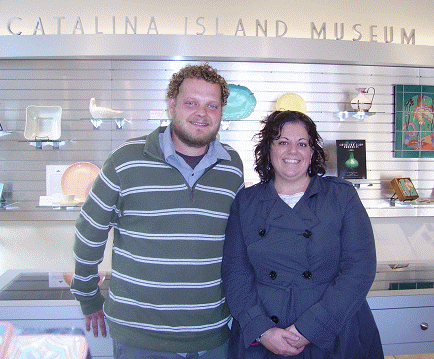

The Catalina Island Museum was a must see on our most recent visit to the Island. At present its feature exhibition is the role Catalina played during World War 2. Troops arrived on the Island immediately after the Pearl Harbor attack with the first emphasis on establishing what was then a highly secret radar station. This was located on the western side of the island on a high tower. This location was the furthest western point of land facing the Pacific Ocean in Southern California.
Later the OSS, the wartime intelligence agency that later became the CIA, established a presence on Catalina to train special ranger type units on infiltrating behind enemy lines and having the ability to survive off the country. They were the fore runners of today's Ranger groups. Also the OSS set up a Maritime unit to train divers for special missions at sea or on beaches. They were called frog men and evolved into today's Navy Seals.
There is a movie specially prepared by the Armed Forces showing the role of the Island during that wa
Gail Fornaisere of Museum PR was there to greet us and John Boraggina, Curator, gave us a personal tour of the exhibits.
But the Museum has much more to offer as well. Catalina, starting in the 1920s, has always enjoyed a strong link with Hollywood including its celebrities and locations for many films. A film about the old west was photographed with imported America buffalo. These animals prospered on the Island and are still be seen in the Island's interior. The original Mutiny on the Bounty was filmed there. One exhibit displays some one hundred photos of famous visitors including Winston Churchill and movie stars like Natalie Wood and Marilyn Monroe. In fact Marilyn's connection with Catalina is also one of the exhibits since she was a teenage Norma Jean when she first visited the Island with her first husband and long before fame found her.
Another exhibit explains the Island's early history as a native American settlement that existed for hundreds of years before Spanish explorers sighted it in the 1500s. Another the era of William Wrigley Jr., the chewing gum mogul from Chicago who purchased the Island in 1919 and immediately set about bringing it into the modern world. It was he who built the Casino that continues to dominate the Island's shoreline. Construction started in 1928 and was completed in 14 months with much work being done 24 hours a day at the cost of $2 million.
Mr. Wrigley also owned the Chicago Cubs baseball club and started bringing it's players to Catalina for Spring Training. For this purpose he also built the Catalina Country Club, with its handsome clubhouse with dining facilities, and a nine hole golf course.
For one decade, 1027 to 1937 a pottery industry flourished on the Island thanks to it having extensive clay and mineral deposits, ideal for the product. This pottery can still be seen all over Avalon, much of it along the boardwalk fronting the Bay.
Give yourself plenty of time for a visit to the Catalina Island Museum which is located on the ground floor of the Casino. It is open daily from 10 a.m. to 5 p.m. For more information call 310 510-2414, on the web at www.catalinamuseum.org.

Graphic Design by Impact Graphics